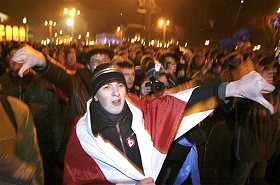
A SOVIET-STYLE ELECTION ENDS IN BELARUS, PROTESTS BEGIN
Publication: Eurasia Daily Monitor Volume: 3 Issue: 55
By:

Belarus has just completed a divisive and fundamentally flawed election campaign. Though the 2006 presidential election has been notable for the public prominence of two opposition candidates, Alexander Milinkevich and Alexander Kazulin, it has ended predictably with the chair of the Electoral Commission announcing yet another sweeping victory for the incumbent, Alexander Lukashenka. On the other hand, the official results have failed manifestly to convince the European Union, the Organization for Security and Cooperation in Europe, Belarus’s western neighbors, and the United States that the process was free and fair. Moreover, the Belarusian elite, especially in Minsk, has become politicized and is no longer swayed by the fear factor as in the past.
The official results are as follows. Lukashenka received 5.46 million votes, or 82.6% of the total; Milinkevich almost 400,000 or 6.0%; Syarhey Haidukevich, leader of the Liberal-Democratic Party, 250,000, or 3.5%; and Kazulin, 154,000, or 2.3%. The official turnout was 92.6%. The chair of the CEC, Lidziya Yarmoshyna, even saw fit to editorialize, commenting that Kazulin’s low vote was a result of his rowdy campaign, a reflection perhaps of the arbitrary nature of the final tally.
Though accurate polling was almost impossible during the campaign, due to the oppressive conditions imposed by the government, available surveys suggest that Lukashenka’s standing was somewhere between 50% and 60%. However, some 30% of the electorate voted at advance polls, meaning that often there were few people actually at polling stations on March 19. Lukashenka’s results may have been raised upward by some 22-25%. In turn the combined total of 11.8% for the three other candidates appears very low.
By election day, the few remaining media and Internet outlets for the two opposition candidates had been curtailed. Narodnaya volya ceased printing after its distribution centers had been persuaded to stop production. Websites, such as those of Charter-97 and Zubr, shut down. The news agency Belapan was also affected. Thus not a single source of impartial reporting remained in the country on March 19.
The Lukashenka regime kept up a barrage of propaganda against the opposition candidates, while arresting hundreds of their campaign team, including every major official in both camps other than the candidates themselves. Lukashenka responded to an opposition call for a public demonstration on Monday, March 20, in October Square by declaring that he would wring the necks of his opponents as he would a chicken. Throughout the campaign he deployed the KGB and the Special Forces to intimidate his opponents.
Whereas the two opposition candidates each had two radio and TV addresses of less than 30 minutes, the president, who had opted not to campaign, appeared constantly on TV and also made two lengthy addresses: the first at the so-called All-Belarusian Congress, which was attended by carefully screened delegates, and a second on Belarusian Television on March 18. His themes were repetitive: current economic stability contrasted with potential chaos under candidates who represented foreign interests, specifically of countries hostile to Belarus.
Western agencies have universally condemned the campaign. A press release from the OSCE, which had over 500 international observers from 38 countries representing its two agencies, the Office for Democratic Institutions and Human Rights and the Parliamentary Assembly, stated that the election failed to meet OSCE commitments. According to Ambassador Geert-Hinrich Ahrens, head of the long-term observation mission, “A positive assessment of this election was impossible.” The EU is debating further sanctions on Belarus.
As for the opposition, it performed creditably within the highly restricted environment. Over 15,000 people came into the streets on the evening of March 19 in the largest public demonstration since Soviet times. The actual figure may have been considerably higher. The protests continued on the evening of the 20th. The essential factor from the perspective of the united opposition is the maintenance of unity in the post-election period. Such a goal may induce Kazulin to form a new alliance with Milinkevich. The two were working in virtual unison by the end of the campaign; and now face a vindictive government anxious to punish the opposition candidates.
It is a truism that Belarus is different; that national consciousness (including the use of the native language) lags well behind that of its neighbors, and that the outlook of its president is not alien to large sectors of the population. Milinkevich’s appeal has been to the intelligentsia, the urban elite, and above all to young activists who do not see a future for their country within a post-Soviet and authoritarian regime, ostensibly under the permanent presidency of a quasi-dictator with little to offer other than platitudes about stability, close partnership with Russia, and a system of internal terror.
The quest for the hearts and minds of the people — a frequently used phrase of Milinkevich — has just begun. But it cannot be measured adequately from the perspective of an election so closely controlled by the government, with a leader who indulged in and used the threat of violence and oppression to get his way. This was a disgraceful election in many aspects, but one that revealed starkly and accurately the true nature of the Lukashenka regime. The reported results are meaningless.
(Sovetskaya Belorussiya, March 18 and 20; BBC Monitoring, March 19; OSCE Press Release, March 20; Charter-97, March 19)




